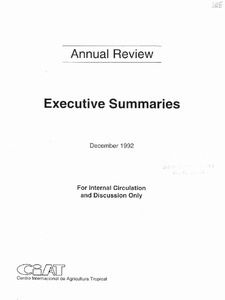Assessing complex interactions between human and agro-ecosystem using satellite information. A case study in Katuk Odeyo, Western Kenya.
The objective of this study is to integrate socioeconomic, biophysical, and remote-sensing information to enhance the understanding of climate change, agriculture and food security within and between CCAFS sites. The purpose is to assess the agricultural production system in the CCAFS site Katuk Odeyo, Nyando (Western Kenya) to explore potential indicators that can be long-term monitored. Ecosystem health determines energy supply and demand by sustaining the productive capacity of the landscape.
Assessing the impact of integrated natural resource management: Challenges and experiences
Assessing the impact of integrated natural resource management (INRM) research poses a challenge to scientists. The complexity of INRM interventions requires a more holistic approach to impact assessment, beyond the plot and farm levels and beyond traditional analysis of economic returns. Impact assessment for INRM combines the traditional "what" and "where" factors of economic and environmental priorities with newer "who" and "how" aspects of social actors and institutions. This paper presents an analytical framework and methodology for assessing the impact of INRM.
Assessment of skimming well performance in Punjab, Pakistan by groundwater simulation modelling
Assisting community management of groundwater: irrigator attitudes in two watersheds in Rajasthan and Gujarat, India
The absence of either state regulations or markets to coordinate the operation of individual wells has focussed attention on community level institutions as the primary loci for sustainable groundwater management in Rajasthan and Gujarat, India. The reported research relied on theoretical propositions that livelihood strategies, groundwater management and the propensity to cooperate are associated with the attitudinal orientations of well owners in the Meghraj and Dharta watersheds, located in Gujarat and Rajasthan respectively.
Baseline characterization of production and markets, technologies and preferences, and livelihoods of smallholder farmers and communities affected by HIV/AIDS in Swaziland
Beyond zero deforestation in the Brazilian Amazon Progress and remaining challenges to sustainable cattle intensification
Key Messages
• A governance approach, combining public policy and private initiatives was effective in slowing down deforestation, but
was unable to support a transition to more sustainable production systems.
• New technical intensification models must be identified for low-productivity systems in degraded lands, adapted to the
biophysical and sociotechnical conditions of the Amazonian landscapes.
• Multiple constraints inhibit progress toward sustainable intensification of cattle ranching, and reversing them requires that
Big win: Trees on agricultural land sink four times more carbon
Recent studies show that carbon
sequestered by trees on agricultural
land is not well accounted for. If it was,
researchers argue in a new study: “Global
Tree Cover and Biomass Carbon on
Agricultural Land: The contribution
of agroforestry to global and national
carbon budgets,” total carbon estimates
from agricultural land could be more
than four times higher.
Building a consolidated community global cropland map
This paper describes the start of a data sharing process to develop a consolidated community cropland map, which was initiated through a recent workshop on characterizing and validating global agricultural land cover. Participants from different organizations around the world were asked to contribute their various cropland maps prior to the workshop. Other data such as geo-tagged photos, in-situ data, classified satellite images and videos also were provided as part of this process. The data are now available online at agriculture.geo-wiki.org.








